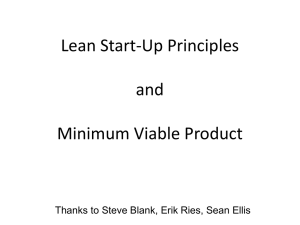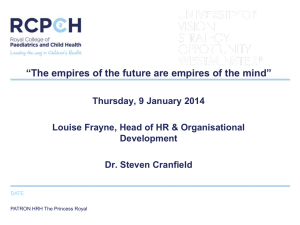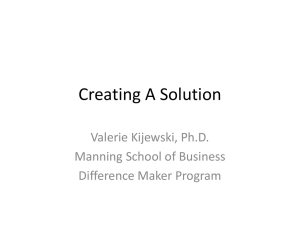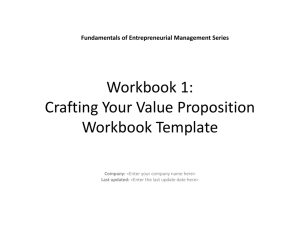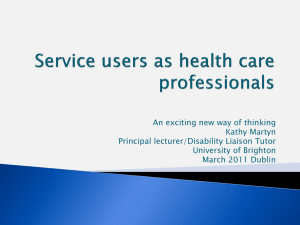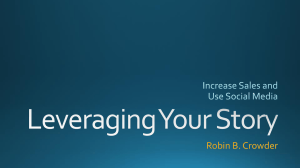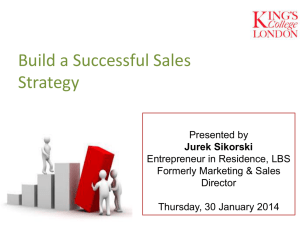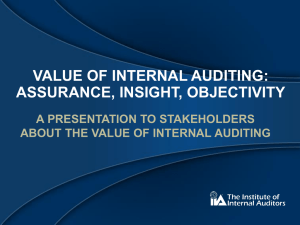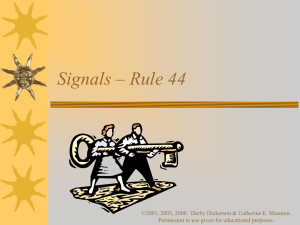Lecture 2
advertisement
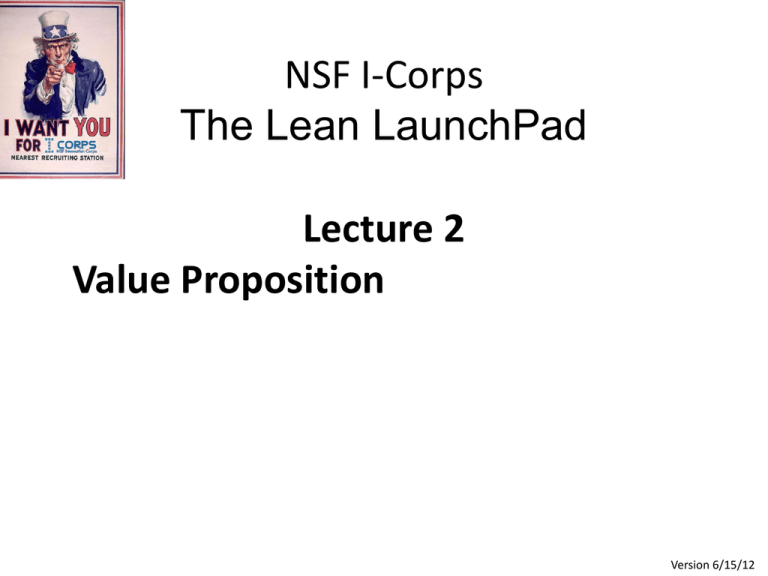
NSF I-Corps The Lean LaunchPad Lecture 2 Value Proposition Version 6/15/12 Value Proposition What Are You Building and For Who? © 2012 Steve Blank Product/Market Fit The Value Proposition Gain Creators Products & Services MVP Pain Killers Pain = Customer Problem Gain = Customer Solution The Customer Segment Gains Persona • Jobs /Archetyp • Problem or e Need Pains Market Type Gain Creators Gains Products & MVP Services • Jobs • Problem or Need Pain Killers Persona /Archetyp e Pains Product/Market Fit Product/Services Value Proposition - Products • Which are part of your value proposition? – (e.g. manufactured goods, commodities, produce, ...) • Which intangible products are part? – (e.g. copyrights, licenses, ...) • Which financial products? – (e.g. financial guarantees, insurance policies, ...) • Which digital products? – (e.g. mp3 files, e-books, ...) Value Proposition - Services • Which core services are part of your value proposition? – (e.g. consulting, a haircut, investment advice, ...) • Which pre-sales or sales services? – (e.g. help finding the right solution, financing, free delivery service, ...) • Which after-sales services? – (e.g. free maintenance, disposal, ...) Pain Killers Reduce or eliminate wasted time, costs, negative emotions, risks - during and after getting the job done Pain Killers - Hypotheses • Produce savings? – (e.g. time, money, or efforts, …) • Make your customers feel better? – (e.g. kills frustrations, annoyances, things that give them a headache, ...) • Fix underperforming solutions? – (e.g. new features, better performance, better quality, ...) • Ends difficulties and challenges customers encounter? – (e.g. make things easier, helping them get done, eliminate resistance, ...) • wipe out negative social consequences? – (e.g. loss of face, power, trust, or status, ...)... • Eliminate risks – (e.g. financial, social, technical risks, or what could go awfully wrong, ...) Pain Killer – Is it a Problem or Need? • Are you solving a Problem? • Are you fulfilling a Need? • For who? • How do you know? Pain Killer - Ranking • Rank each pain your products and services kill according to their intensity for the customer. • Is it very intense or very light? • For each pain indicate the frequency at which it occurs Gain Creators How do they create benefits the customer expects, desires or is surprised by, including functional utility, social gains, positive emotions, and cost savings? Gain Creators- Hypotheses • Create savings that make your customer happy? – (e.g. in terms of time, money and effort, ...) • Produce expected or better than expected outcomes? – (e.g. better quality level, more of something, less of something, ...) • Copy or outperform current solutions that delight customer? – (e.g. regarding specific features, performance, quality, ...) • Make your customer’s job or life easier? – (flatter learning curve, usability, accessibility, more services, lower cost of ownership, ...) • Create positive consequences that customer desires? – (makes them look good, produces an increase in power, status, ...). Gain Creator- Ranking • Rank each gain your products and services create according to its relevance to the customer. • Is it substantial or insignificant? • For each gain indicate the frequency at which it occurs. Minimum Viable Product Define Minimum Viable Product – Physical • First, tests your understanding of the problem (pain) • Next tests your understanding of the solution (gain) – Proves that it solves a core problem for customers • The minimum set of features needed to learn from earlyvangelists - Interviews, demos, prototypes, etc - Lots of eyeball contact Define the Minimum Viable Product – Web/Mobile • NOW build a “low fidelity” app for customer feedback – tests your understanding of the problem • LATER build a “high fidelity” app tests your understanding of the solution – Proves that it solves a core problem for customers – The minimum set of features needed to learn from earlyvangelists - Avoid building products nobody wants - Maximize the learning per time spent The Art of the MVP • A MVP is not a minimal product • “But my customers don’t know what they want!” • At what point of “I don’t get it!” will I declare defeat? Things to Consider Value Proposition – Common Mistakes • It’s just a feature of someone else’s product • It’s a “nice to have” instead of a “got to have” • Not enough customers care Questions for Value Proposition • Competition: What do customers do today? • Technology / Market Insight: Why is the problem so hard to solve? • Market Size: How big is this problem? • Product: How do you do it? Key Questions for Value Prop • Problem Statement: What is the problem? • Ecosystem: For whom is this relevant? • Competition: What do customers do today? • Technology / Market Insight: Why is the problem so hard to solve? • Market Size: How big is this problem? • Product: How do you do it? Technical Versus Market Insight Technology and Market Insight • • • Technology Insight Moore’s Law New scientific discoveries Typically applies to hardware, clean tech and biotech Market Insight Value chain disruption Deregulation Changes in how people work, live and interact and what they expect Examples of Technical Insight • Topological analysis enables highly dimensional data to be analyzed without predetermining number of feature sets Mass produced components can be used to create a miniaturized fluorescence microscope Examples of Market Insight • People want to play more involved games than what is currently offered • Facebook can be the distribution for such games Masses of people are more likely to microblog than blog The non-symmetric relationships will allow companies and individuals to self-promote and will impact distribution European car sharing sensibilities could be adopted in North America People, particularly in urban environments, no longer wanted to own cars but wanted to have flexibility. Types of Value Propositions Comes from Technical Insight More Efficient Smaller Faster Lower cost Comes from Market Insight Better Distribution Simpler Better Branding Better Bundling Insight • All of you are starting with technical insight • All of you will get out of the building and get data • A few of view will get market insight Examples Value proposition Problem • Non-renewable, petroleum derived feedstock for surfactant, lubricant industry Solution • Sustainable, biobased replacement • Higher performance • Improved cold temperature tolerance of detergents, lubricants Features of value proposition • Bi-functional molecules • Flexibility in chain length • Flexibility in branching Hand weed control is a Nightmare Crews of 100s needed Labor getting harder to get Back-breaking task 2-3 weedings per crop Food contamination risk $250-1,000 per acre Confidential Disposal Produced Water Dilution with Freshwater Reuse to Frac Another Well Primary Treatment This is where we fit in How high can they go? Tertiary Treatment Current state of the art are evaporators and crystallizers Discharge Must be drinking water quality MammOptics Initial Idea Breast cancer Mammography Leading cause of cancer in women 190,000 diagnosis every year US 41,000 deaths every year US Increasing diagnosis rates 15%-25% false negatives rate 25% false positives rate Requires X-ray radiation Low resolution MammOptics Novel technology based on RFmodulated optical spectroscopy - Earlier detection - Non-radiative - Non-invasive The Problem & Our Solution De-mineralization X Problem: No products that reverses demineralization effectively Our solution: Remineralization peptides that restore lost mineral
